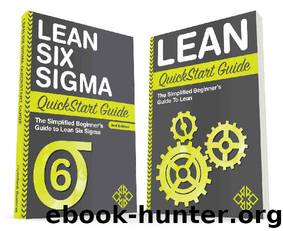Lean Six Sigma: and Lean QuickStart Guides - Lean Six Sigma QuickStart Guide and Lean QuickStart Guide (Lean Six Sigma For Service, Lean Manufacturing) by ClydeBank Business

Author:ClydeBank Business [Business, ClydeBank]
Language: eng
Format: epub
Publisher: ClydeBank Media LLC
Published: 2016-02-08T05:00:00+00:00
2. A Broad View
While the first aspect deals with the all-important process of identifying—and reducing—waste, the second component of Lean philosophy deals with strategy and planning. Lean focuses on thinking strategically and incorporating long-term planning into everyday operations. An organization’s success should be viewed with a focus on the long term and in the context of the industry-at-large; short-term gains are not a reliable measure of success. This approach is not intended to trivialize short-term development, but rather to put it in perspective toward maintaining a competitive advantage within a given industry.
If, for example, a firm’s goal is to acquire the lion’s share of the market within which they operate, then a large variety of factors must be taken into account. If this firm’s (Firm A) sales goals are consistently beaten by 9 percent each quarter, that is certainly good news. When taking a broad view, however, the firm sees that a competitor (Firm B) is consistently beating their own sales goals by 11 percent. This is still not quite the big picture and doesn’t present instructive insight.
Firm B owns a smaller market share than Firm A, and though sales are on the rise, that smaller market share translates into lower overall profits. While Firm B is making aggressive sales, Firm A is still on track to their strategic goals. This contextualizes the rate of Firm B’s growth, and can help decision makers at Firm A further realize their organization’s goals.
Conceptually, the broad view approach can be implemented at the day-to-day level by matching tactical and operational tasks and decisions with strategic level goals and avoiding tunnel vision style production. Tunnel vision production focuses on the product or the process and not on the customer, therefore making non-value-added activities harder to detect and, in many cases, leading to excessive production.
Firm A’s strategic goal was to control the largest market share in each of its businesses’ product lines, but perhaps the strategic goal of Firm B was to offer superior service and quality. These broad view strategies can be reduced to their simplest terms by working backward—superior service means on-time delivery, on-time delivery means tight scheduling on the factory floor, tight scheduling means examining processes, etc. Once the day-to-day functional building blocks are established at the production level, their supervision and execution can be tied to the broad view strategy and help align business activities at all levels of the organization. The practice of aligning daily operations with a “broad view” mentality ensures that all decisions are matched appropriately to the organization’s long-term goals.
This approach also helps organizations to avoid becoming too goal-focused, which at face value doesn’t sound like a negative circumstance at all. But consider this: if a team or a department is too focused on simply reaching its established goals or conforming to its specified budget, then there is a significant opportunity for those individuals to lose track of the company’s overall waste reduction goals. Work could be done toward goals that don’t fit into the company’s strategic position, creating more work, which inevitably will be non-value-added waste.
Download
This site does not store any files on its server. We only index and link to content provided by other sites. Please contact the content providers to delete copyright contents if any and email us, we'll remove relevant links or contents immediately.
Hit Refresh by Satya Nadella(9011)
The Compound Effect by Darren Hardy(8760)
Change Your Questions, Change Your Life by Marilee Adams(7589)
Nudge - Improving Decisions about Health, Wealth, and Happiness by Thaler Sunstein(7500)
The Black Swan by Nassim Nicholas Taleb(6969)
Deep Work by Cal Newport(6841)
Daring Greatly by Brene Brown(6395)
Rich Dad Poor Dad by Robert T. Kiyosaki(6343)
Principles: Life and Work by Ray Dalio(6160)
Man-made Catastrophes and Risk Information Concealment by Dmitry Chernov & Didier Sornette(5895)
Playing to Win_ How Strategy Really Works by A.G. Lafley & Roger L. Martin(5817)
Digital Minimalism by Cal Newport;(5611)
Big Magic: Creative Living Beyond Fear by Elizabeth Gilbert(5571)
The Myth of the Strong Leader by Archie Brown(5391)
The Slight Edge by Jeff Olson(5330)
Discipline Equals Freedom by Jocko Willink(5252)
The Motivation Myth by Jeff Haden(5136)
Stone's Rules by Roger Stone(5003)
The Laws of Human Nature by Robert Greene(4949)
